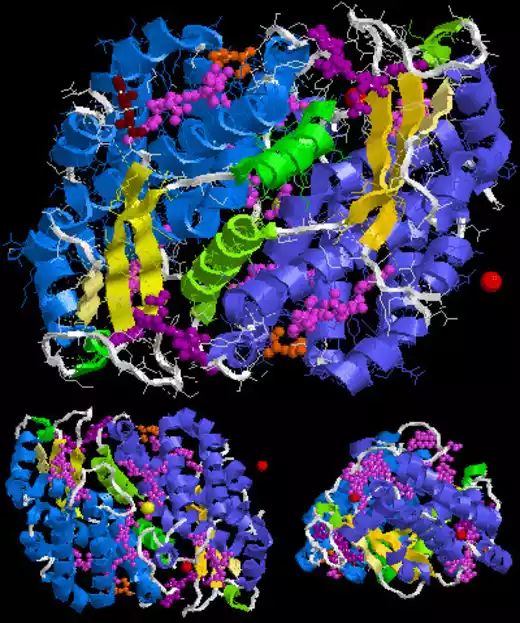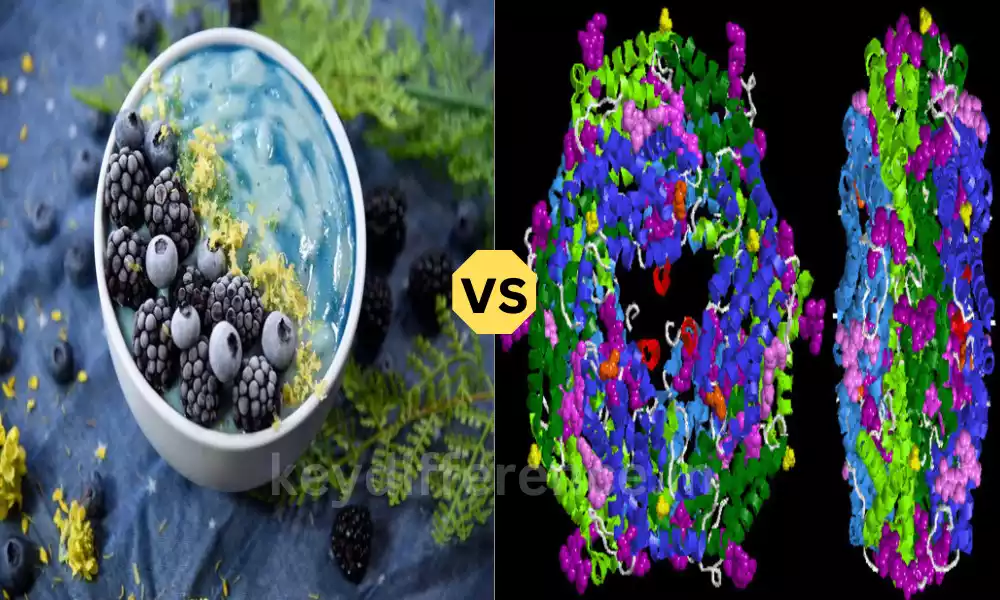Phycocyanin and Phycoerythrin are two vital pigments for photosynthetic production that are found in a variety of species of photosynthetic organisms. These pigments play an important function in capturing sunlight energy for photosynthesis.
They are key elements of phycobilisomes which are complexes that capture light. Although they share a role in photosynthesis, both phycocyanin and phycoerythrin have distinct distinctions with respect to their composition and function, chemical structure, and distribution in different organisms.
What is Phycocyanin?
The pigment phycocyanin is blue and found in cyanobacteria, as well as some kinds in red algae. It is a form of phycobiliprotein which is a group of pigments that play a vital part in the process of photosynthesis.
The phycocyanin pigment absorbs light the most effectively in the red and blue areas of the electromagnetic spectrum. It acts as an accessory pigment that captures sunlight and transfers it to chlorophyll to be used in photosynthesis.
The distinct blue color is an essential component of the complexes that harvest light within photosynthetic organisms.

What is Phycoerythrin?
Phycoerythrin is a red pigment present in many photosynthetic organisms such as red algae and Cyanobacteria. It is part of the phycobiliprotein group, which comprises pigments involved in photosynthesis.
Phycoerythrin effectively absorbs light in the blue and green areas that make up the electromagnetic spectrum which allows it to be a part of the absorption spectrum of chlorophyll.
The pigment captures the energy from light and transmits it to the reactions of the photosynthetic process, allowing photosynthesis organisms to use an array of light wavelengths to convert energy.
The distinct red color of Phycoerythrin is a contributing factor to the overall coloration of red algae and is a key component in their photosynthesis processes.

Importance of these pigments in photosynthetic organisms
Phycoerythrin and phycocyanin are the two most important pigments found in photosynthetic organisms because of their essential functions in the absorption of light as well as energy transfer.
Their significance can be summed up in the following manner:
- Absorption of Light: Phycocyanin and phycoerythrin both have distinct absorption spectrums that are in line with the spectrum of absorption for chlorophyll. This allows photosynthetic organisms to absorb a wider range of wavelengths for light, especially in the green and blue areas that make up the spectrum. The expanded light capture improves the productivity of photosynthesis by permitting organisms to capture more energy from light to convert carbon dioxide, water, and sugars into oxygen.
- Energy Transfer: The substances serve as light-harvesting apex antennas within complexes of photosynthetic activity, like phycobilisomes. They absorb the energy of light and then transfer it into the main pigment, chlorophyll. This process of energy transfer is crucial for launching the electron transport chain for photosynthetic production and triggering the synthesis of the adenosine triphosphate (ATP) and the reduction of equivalents. These are vital for the metabolic process of the organism.
- Adjustment to Specific Conditions: of light Phycocyanin and phycoerythrin are frequently found in species that thrive in particular aquatic conditions. Phycoerythrin is a good example.
It is common in deep-water algae since it is extremely efficient in the absorption of light wavelengths that penetrate deeper. This adaptation enables these algae to live and photosynthe in their niches of ecological significance. - Protection against Photodamage: The pigments offer protection from excessive light energy, which could cause photodamage. In conditions of high light, certain photosynthetic organisms are able to dissipate excess energy via processes that involve protein phycobiliproteins. They help to reduce the oxidative stress that can cause the destruction of cellular components.
- Environmental Significance: This pigment’s presence in a variety of photosynthetic species contributes to the overall diversity and ecological balance of ecosystems of the water. They aid in the development and survival of a variety of freshwater and marine species, ranging from algae to cyanobacteria. These constitute the basis of the food web in the water. Phycocyanin as well as phycoerythrin are essential pigments that enhance the energy capture process and light transfer in photosynthesis organisms.
Their distinct characteristics as well as functions make them indispensable in the efficient conversion of the energy of light into chemical energy which is essential to ensure the existence and growth of these organisms as well as the ecosystems they reside in.
Comparison Table of Phycocyanin and Phycoerythrin
Here’s a comparison table highlighting the key differences between phycocyanin and phycoerythrin:
| Characteristic | Phycocyanin | Phycoerythrin |
|---|---|---|
| Color | Blue | Red |
| Absorption Spectrum | Peaks in blue and red regions | Peaks in green and blue regions |
| Chemical Composition | Composed of α and β subunits | Composed of α and β subunits |
| Molecular Structure | Phycobiliprotein | Phycobiliprotein |
| Function | Captures and transfers blue light | Captures and transfers green light |
| Energy Transfer | Transfers energy to chlorophyll | Transfers energy to chlorophyll |
| Localization | Found in cyanobacteria and algae | Found in red algae and some cyanobacteria |
| Occurrence | Widely distributed in photosynthetic organisms | Predominantly in red algae and certain cyanobacteria |
| Adaptation to Light Conditions | Functions well in high-light conditions | Efficient in low-light and deep-water environments |
| Ecological Significance | Supports various aquatic ecosystems | Common in deep-water environments, contributing to biodiversity |
This table summarizes the main differences and distinctions between phycocyanin and phycoerythrin, emphasizing their color, absorption spectra, composition, function, localization, and ecological significance.
Localization within photosynthetic organisms
The phycoerythrin and phycocyanin are located in photosynthetic organisms in different ways:
Phycocyanin:
- It is found in cyanobacteria. These are photosynthesis bacteria, as well as certain types of red algae.
- In cyanobacteria, phycocyanin is found within the membranes of the thylakoid, which is in which photosynthesis occurs. It is part of phycobilisomes. They are complexes that harvest the energy of light and transmit it to chlorophyll for photosynthesis.
- The presence of Phycocyanin is most prominent in cyanobacteria and is responsible for their bluish-green hue.
Phycoerythrin:
- Phycoerythrin is primarily found in red algae, as well as some Cyanobacteria.
- The phycoerythrin in red algae can be present in the phycobilisomes similar to the presence of the cyanobacteria. These complexes are found in the chloroplasts in red algae, where photosynthesis takes place.
- The high concentration of phycoerythrin found in red algae plays a role in their distinctive red hue.
The pigments form an integral part of the machinery for photosynthetic production and are responsible for capturing light energy and transferring it to chlorophyll for energy conversion. Their precise location within the photosynthetic organisms is tailored to the niches of ecology and the light conditions under which they thrive.
Types of organisms containing phycocyanin
The most common phycocyanin species are the cyanobacteria as well as some varieties of red algae.
Here are more details on the kinds of organisms that contain this phycocyanin:
- Cyanobacteria (Blue-Green algae): Phycocyanin is abundant in cyanobacteria, which is a group of photosynthetic bacteria that are commonly referred to as blue-green algae. Cyanobacteria can be found in a variety of habitats, from freshwater ecosystems to marine, and have a key role to play in the production of oxygen through photosynthesis.
- Red Algae: Although red algae are typically linked to phycoerythrin, certain species of red algae could contain phycocyanin in particular in their initial stages of development. The presence of phycocyanins in red algae can be attributed to their diverse colors of red, brown-red, and violet hues.
It is important to know that phycocyanin is not as prevalent in other photosynthetic organisms. Its most prominent presence is found in the cyanobacteria as well as certain red algae.
Types of organisms containing phycoerythrin
Phycoerythrin is found mainly within red algae but it may also be found in cyanobacteria.
Here are some more information about the different kinds of organisms that have this phycoerythrin-like substance:
- The Red Algae (Rhodophyta): Phycoerythrin is the primary pigment of red algae. They get their name from the reddish or red coloration that results from the presence of phycoerythrin as well as other pigments. Red algae are marine life and are prevalent in deep and shallow waters. Phycoerythrin is an essential component in the capture of light energy for photosynthesis within these organisms.
- Certain Cyanobacteria: While phycocyanin is the most prevalent phycobiliprotein found in cyanobacteria, certain species could also contain phycoerythrin. Phycoerythrin is particularly prevalent in cyanobacteria found in extreme environments, like hypersaline or hot springs which provide these organisms with an advantage in absorption of light.
The most widely-known function lies in algae that are red which is where it plays a role in the distinctive red hue and acts as a key photosynthetic pigment. The presence of cyanobacteria in certain species shows adaptations to specific habitats and lighting conditions.
Wavelengths of maximum absorption
The wavelengths of absorption at the maximum for phycocyanin and phycoerythrin can be found as the following:
Phycocyanin:
- Phycocyanin has two main absorption peaks:
- The wavelength of absorption maximum (lmax) of the blue area, is usually about 620-640 nanometers (nm).
- Another Lmax in the red region is usually between 650 and 700 nm.
Phycoerythrin:
- Phycoerythrin can also have two main absorption peak levels:
- The wavelength of absorption maximum (lmax) within the region of green. It is typically between 540 and 565 nanometers (nm).
- Another Lmax is located in the blue area, typically between 495 and 515 nm.
The distinctive absorption spectra are what make phycocyanin as well as phycoerythrin so valuable in photosynthesis because they permit organisms that photosynthesis to take advantage of the broadest range of wavelengths of light and convert energies into chemical energy in a way that is efficient.
Chromophores and prosthetic groups
Both phycocyanin and phycoerythrin are characterized by particular chromophores and prosthetic groups that contribute to their distinctive color and properties for absorbing light:
Phycocyanin:
- The phycocyanin protein contains two types of chromophores, namely both phycocyanobilin and phycocyanobilin-lya. The chromophores are attached covalently to the structure of the protein the phycocyanin. The phycocyanobilin protein is the reason for the blue-colored appearance of phycocyanin. It is bonded to the protein via a connection with thioether. Phycocyanin also includes a prosthetic group known as phycocyanobilin protein lyase, which is involved in the attachment of the chromophores to the protein subunits.
Phycoerythrin:
- Phycoerythrin is a phycoerythrobilin-containing principal chromophore. Phycoerythrobilin is the reason for the red hue of phycoerythrin. It’s covalently linked to protein subunits by a thioether connection. Similar to phycocyanin, phycoerythrin uses a specialized prosthetic group referred to as phycoerythrobilin Lyase to aid in the attachment of the chromophore proteins.
The chromophores and prosthetic groups are vital to absorb specific wavelengths of light and for the transport of electrons to chlorophyll and other pigments of the photosynthetic complexes of phycobilisomes.
They are the most important elements that allow the pigments in these complexes to act as effective energy-transfering and light-harvesting molecules within photosynthetic living organisms.
Complementary roles within photosynthetic organisms
Phycoerythrin and phycocyanin play different functions in the photosynthesis of organisms, particularly when they are in the same cell environment.
They are frequently seen in cyanobacteria, as well as certain red algae:
- Absorption of various wavelengths: Phycocyanin primarily absorbs light from the red and blue areas of the spectrum however, phycoerythrin absorbs light from the blue and green regions. This spectrum of absorption complements each other, allowing the organism to take advantage of more light wavelengths that are needed for photosynthesis.
- Energy Transfer: The phycoerythrin and phycocyanin act as light-harvesting pigments, which absorb the energy of light and transmit it to chlorophyll and other primary pigments. The phycocyanin channelizes blue light to chlorophyll while the phycoerythrin transfers green light energy. This energy transfer assures the most amount of light energy is utilized for photosynthesis.
- Adaptation to light conditions: Phycocyanin is more efficient in bright light conditions, which makes it ideal to absorb sunlight near the surface of the water. Contrarily, phycoerythrin can be more efficient in low-light or deep-water environments where blue and green light are predominant. This is because they assist photosynthetic organisms to adapt to their particular light niches.
- The Balancing of Light Absorption: It is the case that phycocyanin as well as phycoerythrin permits the photosynthetic organism to control the absorption of light. If one pigment is less effective because of changes in the light circumstances or depths of water, the other will absorb light from various parts of the spectrum.
- Protection from Photodamage: When the light is intense excessive light energy could result in photodamage and an increase in oxidative stress. The presence of phycocyanin as well as phycoerythrin allows the body to reduce excess energy and lower the chance of photodamage and improves overall health and longevity.
These roles, in combination with the capacity to adapt to changing conditions of light, make phycocyanin and phycoerythrin crucial elements of the apparatus for photosynthetic production in these organisms, assuring efficient energy capture and transfer in addition to their capacity to thrive in various ecological niches.
The significance of these pigments in the world of photosynthetic organisms
The phycocyanin and the phycoerythrin have an important role in the photosynthesis of organisms due to their significance in maximizing the capture of light and transfer of energy to photosynthesis.
Their importance can be summed up in the following manner:
- Enhanced Light Absorption: These pigments expand the spectrum of wavelengths organisms that are photosynthetic can absorb. Both phycoerythrin and phycocyanin absorb light in various parts of the spectrum, which allows us to make more efficient use of the available light energy especially in conditions with variable lighting conditions.
- Energy Transfer: The phycoerythrin and phycocyanin function as light-harvesting pigments that capture sunlight energy and transmit it to chlorophyll as well as various other main pigments. The process of transferring energy is vital for triggering photosynthesis, and also for producing Adenosine Triphosphate (ATP) and the reduction of counterparts. These are vital for the various metabolic processes.
- Adaptation to ecological Neches: These pigments enable photosynthesis organisms to adapt to niches in the ecology. Phycocyanin can be effective in bright conditions, which makes it ideal for living on surfaces, while it is particularly effective in low-light or deep-water habitats. The ability to adapt allows organisms to thrive in various habitats.
- Protection against Photodamage: Under high-light conditions excessive light energy could result in photodamage and oxidative stress. The phycoerythrin and phycocyanin are able to disperse excess energy, thereby serving as a protection mechanism against damage to the photo and helping to ensure the health and longevity of photosynthesis-related organisms.
- Diversity and ecological balance: A high concentration of phycocyanin and/or phycoerythrin among various photosynthetic species can contribute to the diversity and balance of the ecological system in ecosystems of the water. They help to promote the development and survival of a broad range of freshwater and marine species, including cyanobacteria red algae, as well as other microorganisms.
- Biotechnological applications: These pigments are used for useful applications in biotechnology where they can be used as markers that emit light and are used in a variety of research methods like fluorescence microscopy and flow cytometry. They are also used in pharmaceuticals, food coloring, and cosmetics.
The significance of phycocyanin as well as phycoerythrin in this world of organisms that use photosynthetic chemicals is in their ability to maximize the capture of light, adapt to various light conditions, shield against photodamage and maintain the balance of ecosystems in aquatic ecosystems.
Their distinctive properties are essential to the apparatus for photosynthetic production and can be utilized in a variety of areas.
Conclusion
The phycocyanin as well as the phycoerythrin form the primary pigments that are essential to the life of photosynthetic organisms. Their respective functions in the absorption of light and transfer of energy allow these organisms to flourish in various ecological niches, adjust to changing light conditions, and guard against damage to photons.
These pigments have a major role to play in photosynthesis, but also play a role in the balance of ecosystems in aquatic ecosystems, and are able to be utilized in uses in biotechnology. Their importance underscores their significance in the web of life as well as research.







